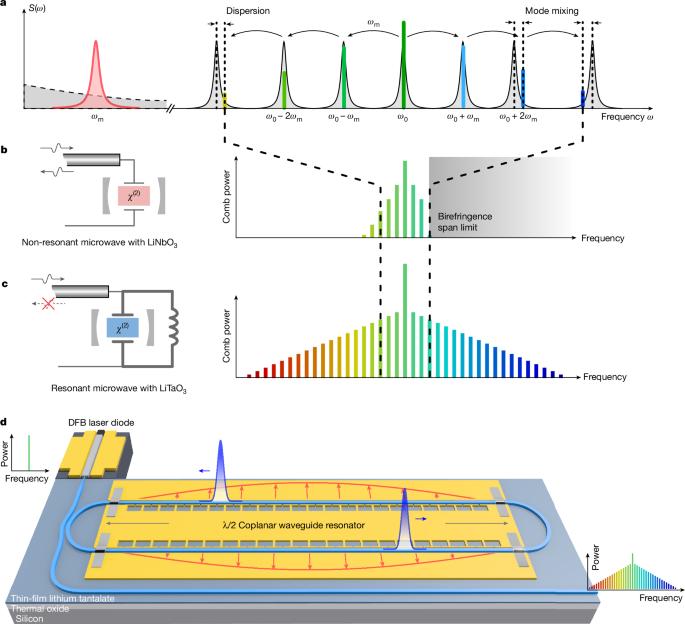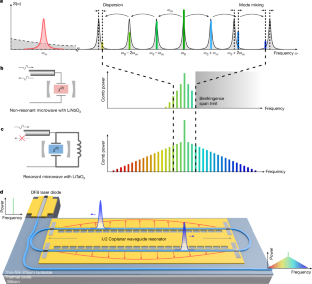钽酸锂中超宽带集成电光频率梳
IF 48.5
1区 综合性期刊
Q1 MULTIDISCIPLINARY SCIENCES
引用次数: 0
摘要
基于Kerr参数振荡的集成频率梳发生器已经产生了芯片级、千兆赫间隔的梳,具有跨超大规模电信、低噪声微波合成、光探测和测距以及天体物理光谱仪校准的新应用2,3,4,5,6。铌酸锂(LiNbO3)光子集成电路(PICs)的最新进展导致了芯片规模的电光(EO)频率梳7,8,提供精确的梳线定位和简单的操作,而不依赖于形成耗散克尔孤子。然而,由于驱动非谐振电容电极所需的微波功率大,以及LiNbO3的强固有双折射,目前集成EO梳子的光谱覆盖范围有限。在这里,我们通过集成三重谐振结构克服了这两个挑战,将单片微波集成电路与基于最近出现的薄膜钽酸锂(LiTaO3)9的PICs相结合。与传统的非谐振微波设计相比,通过共振增强的EO相互作用和减少的双折射,我们实现了4倍的梳子跨度扩展和16倍的功率降低。在混合集成激光二极管的驱动下,梳子的跨度超过450纳米(超过60太赫兹),有2000多条线,而发生器的占地面积仅为1平方厘米。此外,我们还观察到强EO耦合导致梳子存在范围增加,接近光学微谐振器的全自由光谱范围。超宽带梳状发生器与失谐不确定操作相结合,可以推进芯片级光谱分析和超低噪声毫米波合成10,11,12,13,并解锁八度跨度的EO梳状器。微波和光子学的协同设计方法可以扩展到广泛的集成EOs应用。本文章由计算机程序翻译,如有差异,请以英文原文为准。


Ultrabroadband integrated electro-optic frequency comb in lithium tantalate
The integrated frequency comb generator based on Kerr parametric oscillation1 has led to chip-scale, gigahertz-spaced combs with new applications spanning hyperscale telecommunications, low-noise microwave synthesis, light detection and ranging, and astrophysical spectrometer calibration2–6. Recent progress in lithium niobate (LiNbO3) photonic integrated circuits (PICs) has resulted in chip-scale, electro-optic (EO) frequency combs7,8, offering precise comb-line positioning and simple operation without relying on the formation of dissipative Kerr solitons. However, current integrated EO combs face limited spectral coverage due to the large microwave power required to drive the non-resonant capacitive electrodes and the strong intrinsic birefringence of LiNbO3. Here we overcome both challenges with an integrated triply resonant architecture, combining monolithic microwave integrated circuits with PICs based on the recently emerged thin-film lithium tantalate (LiTaO3)9. With resonantly enhanced EO interaction and reduced birefringence in LiTaO3, we achieve a fourfold comb span extension and a 16-fold power reduction compared to the conventional, non-resonant microwave design. Driven by a hybrid integrated laser diode, the comb spans over 450 nm (more than 60 THz) with more than 2,000 lines, and the generator fits within a compact 1-cm2 footprint. We additionally observe that the strong EO coupling leads to an increased comb existence range approaching the full free spectral range of the optical microresonator. The ultra-broadband comb generator, combined with detuning-agnostic operation, could advance chip-scale spectrometry and ultra-low-noise millimetre wave synthesis10–13 and unlock octave-spanning EO combs. The methodology of co-designing microwave and photonics can be extended to a wide range of integrated EOs applications14–16. An integrated electro-optic frequency comb that combines microwave integrated circuits with a photonic circuit based on lithium tantalate leads to broadband operation with low power requirements.
求助全文
通过发布文献求助,成功后即可免费获取论文全文。
去求助
来源期刊

Nature
综合性期刊-综合性期刊
CiteScore
90.00
自引率
1.20%
发文量
3652
审稿时长
3 months
期刊介绍:
Nature is a prestigious international journal that publishes peer-reviewed research in various scientific and technological fields. The selection of articles is based on criteria such as originality, importance, interdisciplinary relevance, timeliness, accessibility, elegance, and surprising conclusions. In addition to showcasing significant scientific advances, Nature delivers rapid, authoritative, insightful news, and interpretation of current and upcoming trends impacting science, scientists, and the broader public. The journal serves a dual purpose: firstly, to promptly share noteworthy scientific advances and foster discussions among scientists, and secondly, to ensure the swift dissemination of scientific results globally, emphasizing their significance for knowledge, culture, and daily life.
 求助内容:
求助内容: 应助结果提醒方式:
应助结果提醒方式:


